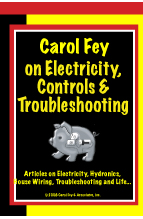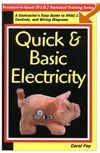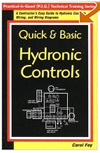by Carol Fey
Comfort, not survival of the human race, is the purpose of a
heating system.Is an electronic thermostat appropriate for hydronic
heating? How about for in-floor heating? Can you use a setback
thermostat for hydronic or in-floor heating?
Them used to be fightin' words not that many years ago. Some
folks in the industry would get pretty hot pretty fast because
"by golly, grandpa didn't use that gol blame stuff and
we don't need to either." Things have loosened up some,
but we're still a bunch that doesn't like new stuff very much.
(Well, except for new trucks. New trucks are great.)
You know where I'm going with this. Electronic thermostats are
great for hydronics and in-floor. And there are applications
for setbacks, too. Keep listening. You're actually going to
like this because you can work some magic with very little time
and money.
Let's take care of the grandpa issue first.
Setback thermostats are not a new idea. The first setback (clock)
thermostat arrived in the early 1900s. It was the original Chronotherm
(chrono is Greek for "time," therm is "heat").
If you work in older houses, you may even have come across one
or two of them. They're a thermostat with a clock face and a
keyhole for an old-fashioned, clock-winding key.
The case is a beautiful piece of metal art. The homeowner would
wind the thermostat clock just like they did the big tick-tock
on the mantel. The first one I saw was in a stately mansion
in St. Paul, Minn., on an original hot water heating system.
Yes, after all these years the whole system was still working.
Electronic thermostats have been around since at least the late
1970s. That's over 30 years ago, so they aren't very new either.
Yes, electronic thermostats work just great with hydronic heating.
When you think about it, why wouldn't they? The reasons are
probably that you or someone you've listened to has had a bad
experience. I have two things to ask about that:
1. How long ago was that? Thirty years is plenty of time for
a problem or two to happen. On the other hand, 30 years is plenty
of time to get the bugs ironed out.
2. Was it a reputable major brand thermostat, or was it a brand
you don't quite remember?Using Electric Thermostats
There are some definite advantages to using electronic thermostats,
in performance, appearance and the impression you make. Let's
start with comfort, the business we're really in.
A recent study using NEMA (National Electrical Manufacturers
Association) standards found that electronic thermostats made
by historically major thermostat manufacturers keep temperature
within a one-degree temperature range. (Not all the others do
so well, so don't assume all electronic thermostats are the
same.) You may recall that two degrees is within the comfort
range of most folks, so this is tight temperature control that
you can't get with an electromechanical thermostat.
In addition to accuracy, here are some reasons to use electronic
thermostats:
-
They look good to many consumers - streamlined, modern;
-
Lots of people think digital is better;
-
They make your job look modern, even if the other controls
and equipment are old stand-bys;
-
They don't come in that old beige color that many consumers
hate (but heating folks still love);
-
You don't have to level them to be accurate (did you know
that a mercury bulb stat is one degree out of calibration for
every degree of level?);
-
They are available in heat-only if air conditioning switching
is a problem.
Now it's time for the yeah-buts.
"Yeah, but digital thermostats cost more." You're
right, the ones worth having do cost a bit more, but not very
much more in the whole scheme of things. And there's the concept
of your mark-up ...
"Yeah but, to tell the truth, I don't know how to program
it and I don't want to learn." Electronic doesn't necessarily
mean programmable. Even so, a good programmable will come with
a standard program in it, so it will still function as a standard
thermostat.
"Yeah, but electronic thermostats don't have anticipators."
That's right. I actually saw one in a distributor's warranty
box marked "anticipator missing" as the reason for
return. But they don't need one.
If you remember back to the purpose of an anticipator, it's
there to determine cycle rate. An electronic thermostat skips
the anticipator and goes directly to cycle rate. It makes the
job easier for us, too, because it figures the amp draw of the
load and adjusts accordingly, rather than having us do it (not
that we did it all that much anyway).
"Yeah, but they don't come in beige, and that means my
fingerprints show." Sigh.Glossary Of Terms
All the thermostat terms flying around can be pretty confusing
- electronic, digital, programmable, setback, clock thermostat,
day-night. Here's the quick sort-out.
Electronic and digital mean the same thing. Those terms mean
there's a digital display, and you can't see what's going on
inside. Electronic does not necessarily mean programmable, though
I've heard of some inspectors that don't know that.
Programmable, setback, clock and day-night are terms interchangeable
with each other. These thermostats can have different temperature
settings at different times. A programmable stat is probably
electronic, though there are some oldies that have an analog
clock and aren't electronic. You can always choose not to program
a programmable thermostat and it will operate anyway, though
maybe not quite like the homeowner wants.
One more term that gets thrown into the pot is "RTU."
An RTU is a sensor that sends information to controls that are
somewhere else.
The assumption, from the 1970s energy crunch, is that the only
purpose of a programmable thermostat is to save money on energy.
And interest in that isn't very high these days. In fact, in
the upscale areas of Colorado and Utah, the big, rich boys have
been known to claim bragging rights over who has the most outrageous
energy bill. (Variations of "mine's bigger" just never
end, do they?)Setbacks And Hydronic Heat
There's a myth that you can't setback with hydronic heat because
you won't be able to get the heat up in time in the morning.
That comes from the assumption that hydronic heat is always
high mass, and that setback needs to be many degrees (10 or
more) to be worth doing.
Neither is necessarily so. Much hydronic heating uses fin tube
as a convector, which is not high mass. Floors aren't necessarily
high mass, either.
Setback doesn't have to be big setback. A few degrees may be
worthwhile. The real purpose of setback these days is (what
business are we really in?) that's right, comfort.
For starters, if you try to sleep under all those upscale down
comforters at normal room temperature, you'll roast. So the
temperature needs to be lower at night, at least in places of
opulent bedding. Of course, no one wants to be the one who gets
up to turn up the temperature, so automation through a thermostat
is necessary.
A comfort expectation that's unique to in-floor heating is that
the floor will be a lovely warm temperature every morning when
those happy bare toes hit the floor. Some homeowners are disappointed
when they can't always feel it. This is a situation where a
programmable thermostat is a relatively inexpensive solution.
"What!" many of you are exclaiming. "You can't
use a setback stat on a radiant floor. The temperature will
never get back up in time." You certainly can by using
just a couple degrees of setback.
Find out what time those bare toes are going to hit the floor,
and program the stat to be in recovery mode then. Recovery mode
means when the heat is coming up in the morning. You can use
a conventional recovery stat where you tell it what time to
start bringing on the heat. Or you can use a stat with intelligent
recovery (costs more but worth it) where you tell it what time
you want it to be fully warm and it does all the thinking to
get it there every day at exactly the right time.
With just a couple degrees setback you don't have much difference
to recover. Intelligent recovery will even make sure you don't
do a setback more than you can recover from.
If you're not already using electronic thermostats, give them
a try for comfort and appearance. And if you've always thought
that programmables and hydronics don't mix, please give it another
thought.
As always, I welcome your comments and knowledge. |




